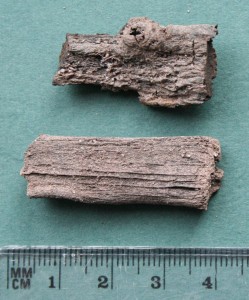
This article was published in the Irish Quaternary Association Newsletter, Issue 53.
Preliminary radiocarbon dating indicates that the marine transgression reached the locus of Cork in the Late Mesolithic or Early Neolithic (between 6.2 and 5.6 ky BP)
The Holocene stratigraphy of the valley-fill at Cork City (River Lee) may be summarized as:
- Fluvial deposits comprising sand and gravel with occasional organic interbeds (Ovens Formation), overlain by:
- Estuarine mud comprising organic silt and peat (Cork Harbour Formation), overlain by:
- Anthropogenic deposits dating from the 11th/12th century (medieval period).
The chronology of the geological sequence is poorly known (Davis et al. 2006). However, a radiocarbon date (UBA-25884: Tuckey Street), awarded by the IQUA, has yielded an important result that builds on preliminary information obtained from two previous dates awarded by the RIA (UBA-18069: Grattan Street and UBA-20749: Woods Street). All three dates were obtained from wood fragments. The wood was present in soil samples that were recovered from engineering boreholes between 1992 and 1997. The fragments, which measure up to 20 mm in diameter, are interpreted as small broken branches of indeterminate type. Two of the dates indicate that organic interbeds within the fluvial sand and gravel (Ovens Formation) were deposited in the Late Mesolithic (4850-4249 cal BC), while the current date shows that peaty silt from the lower part of the Cork Harbour Formation accumulated in the Early Neolithic (3639-3514 cal BC). When taken together, the results provide a chronology for the change from fluvial to marine conditions at the locus of Cork. It is accepted, however, that the wood is derived, and therefore, that the some of the dates may be erroneously old. Nevertheless, an important implication of the radiocarbon dates is that they demonstrate that both the fluvial and estuarine deposits are archaeologically significant.
Careful selection of the samples was necessary because dating evidence from archaeological excavations shows that, during flood events, there has been reworking of the late Holocene sequence. Indeed, significant deposition of sand and silt occurred within reactivated tidal channels as late as the 10th century, shortly before the medieval land-claim.
A review of records of engineering boreholes and historical maps has enabled subsurface plans to be constructed and these show that anastomosing channels characterized both the fluvial and estuarine environments. The organic interbeds, which are preserved only in the youngest part of the sand and gravel sequence, are interpreted as resulting from quieter conditions that occurred towards the end of the fluvial phase (Ovens Formation), while the overlying estuarine silt (Cork Harbour Formation) accumulated in an environment of mudflats and fringing reed marsh.
Reference: Davis, T., McCarthy, I.A.J., Allen, A.R. and Higgs, B. 2006. Late Pleistocene-Holocene buried valleys in the Cork Syncline, Ireland. Journal of Maps, 2006, 79-93.